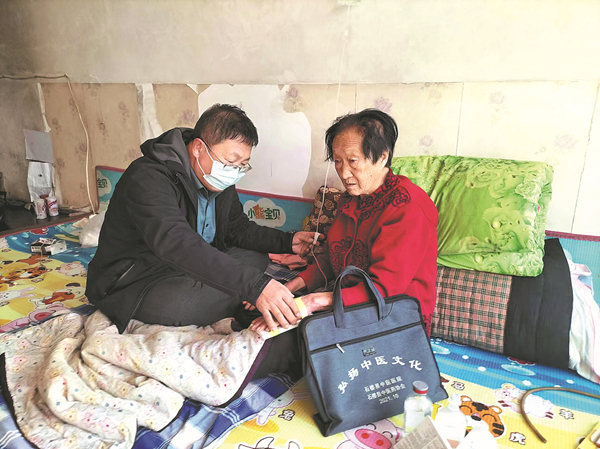Mountain residents get high-quality healthcare
Updated: 2023-02-22

Rural doctor Xin Ping (left) controls the flow of an intravenous drip for an elderly woman at her home in Longjiao town, Shanxi province. [Photo/China Daily]
"To never fail to meet the expectations of the people" has been the motto for Xin Ping, a 52-year-old rural doctor, for nearly three decades. That conviction has anchored him in a clinic nestled in rugged mountains in Shanxi province all that time.
Whether it was riding a bicycle to visit patients in the 1990s or providing consultations via phone or online messaging apps nowadays, Xin said his goal is unchanged — to be by the side of patients in need.
"I was often advised to establish a clinic in the town center, but I cannot imagine leaving my fellow villagers behind," he said. "Over the years, the bond between me and them has become increasingly strong."
Xin, the only staff member at the clinic, is responsible for addressing the medical problems of over 500 residents in two villages in Shanxi's Longjiao township. Residents in nearby villages also rely on him for healthcare advice.
"The clinic was set up in my own house in Xiazhuanghe village until 2015, when authorities funded the establishment of a public rural clinic and improved the working environment quite a lot," he said.
The majority of people still living in the mountainous township are elderly.
"They are unable to travel far due to their health and their children are not around, so I ride a motorcycle to their homes to check on their conditions or deliver medicine. If their condition is serious, I get in touch with higher-level hospitals to transfer them," he said.
That means even a call at midnight jolts Xin up to rush to their bedsides.
"I remember one night, I fell off my motorcycle into a ditch. Looking at my bruised hands and torn clothing, I wanted to cry out loud but quickly calmed down and carried on my way to deliver drugs to an elderly patient with a fever," he said.
Before COVID-19 emerged, Xin visited patients about 2,000 times on average each year, on top of answering questions online from patients in neighboring areas.
"A couple of years ago, I remember seeing all four family members of a household had fallen ill, so I made steamed buns and prepared breakfast for them after finishing their diagnoses," he said.
"I received reciprocal care when villagers offered to help me farm and water walnut trees for me during peak season."
The wave of COVID-19 that swept across the country around December posed fresh challenges, he said.
Xin said that the first local infection was identified on Dec 22.
"Villagers were in a panic at the beginning, so sometimes I had to handle patients visiting me while answering phone calls and messages at the same time," he said.
"Quite a number of them committed the mistakes of taking the wrong types of medicines or excessive amounts of drugs due to a lack of knowledge," he said. "So I had to relentlessly teach them about proper usage, such as that some medicines can only be taken for three straight days at most, and painkillers should be taken at intervals of at least six hours."
Xin said that on the busiest day, he shuttled across eight villages and provided consultations for 83 people. "I felt that COVID-19 seemed ferocious, but symptoms can be eased effectively with the right medications," he said.
One of his oldest COVID-19 patients was 93 years old and is now recovering, Xin said, adding that some severe patients had also been transferred to more developed regions for treatment.
Xin said the pulse oximeters sent to the clinic were a useful tool in coping with the disease. By Jan 23, the local epidemic had subsided and few COVID-19 patients were reported in recent days, according to Xin.



